Research - (2021) Oral and Systemic Health
Association of Dietary Habits and Parental Reported Sleep Tooth Grinding Among Children in Chennai-A Questionnaire Study
Nashwah Hinaz1, Deepa Gurunathan1*, Nivedhitha MS2, Joyson Moses2 and Mahesh Ramakrishnan2
*Correspondence: Deepa Gurunathan, Department of Pediatric and Preventive Dentistry, Saveetha Institution of Medical and Technical Sciences, India, Email:
Abstract
Sleep bruxism (SB) is an oral parafunction characterized by grinding or clenching of the teeth during sleep that is associated with an excessive or intense sleep arousal activity. Bruxism gradually reduces with increase in age. Tooth wear can occur due to various potential factors, among which sleep tooth grinding and dietary habits is one of the factors. The consumption of fruits and vegetables, sweets and chocolates, milk and milk products are related to sleep bruxism. The aim of the study is to associate the dietary habits and parental-reported sleep tooth grinding with tooth wear in children with mixed dentition in chennai. The questionnaire comprised 15 questions which were used to detect the association of dietary habits in children with bruxism. The questionnaire was uploaded on to an online survey platform and results were analysed using SPSS software. Results show that 27.9% children consuming bread and cereals regularly have found to have a habit of clenching teeth, 32.56% children consuming sweet and sugary food regularly clench their teeth and 20.93% children having fizzy drinks once a week have a habit of clenching teeth. Within the limits of the study, it is seen that children consuming bread and cereals, sweet and sugary food, soft/fizzy drinks have a higher incidence of sleep bruxism.
Keywords
Sleep tooth grinding, Bruxism, Dietary habits, Children
Introduction
Tooth wear is defined as “loss of the tooth substance by chemical or mechanical processes”. During childhood, tooth wear increases with age [1], until reaching a prevalence of 80% by the end of the primary dentition [1,2] whilst decreasing to about 30% in adolescents with permanent dentition [1]. Sleep bruxism (SB) is “an oral parafunction characterized by grinding or clenching of the teeth during sleep that is associated with an excessive or intense sleep arousal activity [3].” SB is regarded as the most frequent parasomnias encountered by children [4]. The etiology of SB is complex and multifactorial demanding nutritional, systemic, psychological, occupational, and genetic factors. Recurrent provocation during sleep, which is associated with increased anxiety and stress, is regarded as the main cause of poor sleep quality [5]. SB in young children can also be associated with fatigue of the masticatory musculature, headaches, and noisy breathing during sleep [6,7].
Wear of the teeth in children is the result of combined progression of erosion, attrition, and abrasion [8]. Erosion is usually associated with intrinsic or extrinsic acids. This can be seen in children who tend to consume large quantities of sweets, non-natural juices, citric fruits, and highly carbonated drinks. This leads to more risk of developing tooth erosion [9]. However attrition is more prevalent in subjects with grinding-type bruxism habits, whilst abrasion occurs due to the wearing action of an external object like toothbrush [8]. When an acid environment is present, there is an increased risk of having all types of tooth wear. Due to its multifactorial etiology, tooth wear should be assessed with various factors, including an evaluation of possible conditions, such as dietary habits, soft-drink intake [10], and oral habits like tooth grinding [11,12].
Our department is passionate about child care, we have published numerous high quality articles in this domain over the past 3 years [13- 31]. With this inspiration we planned to pursue research on the association of dietary habits and parental-reported sleep tooth grinding with tooth wear in children with mixed dentition in Chennai.
Materials and Methods
The questionnaire-based study was carried out among Parents with children between the ages of 1-17 years. The questionnaire comprised 15 questions which were used to detect the sleep association of dietary habits and sleep bruxism. The questionnaire was prepared and approved by the scientific review board of the institution. The questionnaire was uploaded on to an online survey platform (google forms) and the link was shared to the parents. The questionnaire was just a screening questionnaire and cannot be used for diagnostic purposes.
Part 1 of the questionnaire was developed to include questions about the child’s age and sex of the child.
Part 2 of the questionnaire was developed to include questions about tooth grinding in sleep and various dietary habits of the child.
Part 3 of the questionnaire was concerned with presence of adverse oral habits in children, the awareness of the parents about the association of dietary habits with tooth grinding as well as presence of various treatments for the sleep bruxism. Based on the responses from the subjects, the statistics were done and the results were obtained in a systematic manner. The statistics was carried out using the IBM SPSS software.
Results and Discussion
The total number of responses were 80, the age of the participants ranged from 1 to 17 years. The highest number of participants were from the age group 5-8 years with 50% as shown in Figure 1 and almost 62.79% participants were females (Figure 2).
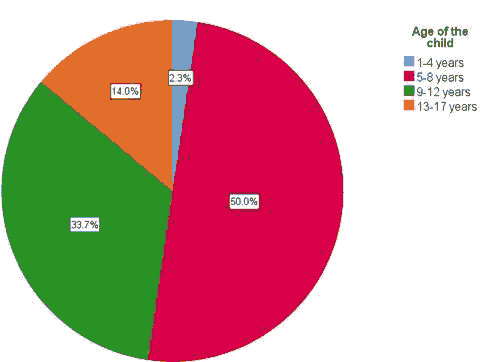
Figure 1: Pie chart showing age of the child in this study (Red represents 1-4 years, green represents 5-8 years, orange represents 9-12 years, and blue represents 13-15 years). The highest number of participants was from the age group 5-8 years with 50%.
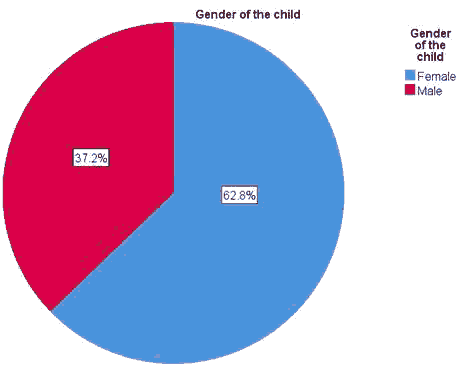
Figure 2: Pie chart showing gender of the child in this study (Red represents male participants and blue represents female participants). The highest number of participants was from females with 62.79%.
This questionnaire based study assessed the relationship of parental-report STG and dietary habits with tooth wear in children with a mixed dentition. To test the association, parents were requested to complete a questionnaire regarding prevalence of bruxism, and various dietary habits were correlated with presence of tooth grinding. Figure 3 shows response of the parents to the child consuming breads and cereals in their diet and its association to presence of clenching of his/her teeth at night. 27.9% children consuming bread and cereals regularly are found to have a habit of clenching teeth and 4.7% children who don't consume bread and cereals have found to have a habit of clenching teeth. Figure 4 shows response of parents to the child consuming milk and milk products in diet and it is seen that 39.53% children consuming milk and milk products regularly do not have a habit of clenching teeth and 34.88% children have a habit of clenching teeth. Figure 5 shows response of the parents to the child consuming sweet and sugary foods in their diet and its association to presence of clenching of his/ her teeth at night , 32.56% children consuming sweet and sugary food regularly have a habit of clenching teeth. According to Figure 6 it is seen that 20.93% children having fizzy drinks once a week have a habit of clenching teeth. Only 4.65% of children having fizzy drinks more than 3 times a week show clenching of teeth. Figure 7 shows response to the child having fruits and vegetables in their diet and its association to presence of clenching of his/her teeth at night. 23.26% children having fruits and vegetables once a week do not have a habit of clenching teeth. Only 16.28% of children having fruits and vegetables 2-3 times a week show clenching of teeth.
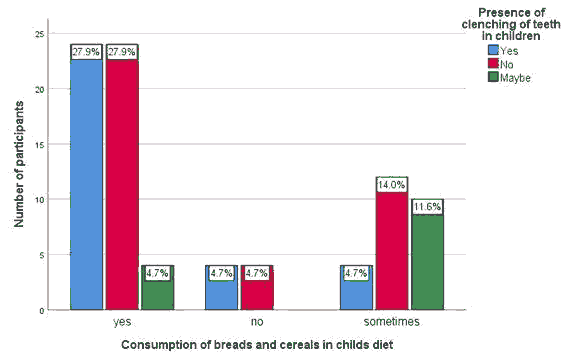
Figure 3: Bar graph showing response to the child consuming breads and cereals in their diet and its association to presence of clenching of his/her teeth at night (Blue graph depicts yes, red- no, green- maybe). X axis shows response to consumption of breads and cereals in diet and Y axis shows number of participants. 27.9% children consuming bread and cereals regularly have found to have a habit of clenching teeth. However this was statistically significant (Pearson’s chi square test; p value=0.00-significant).
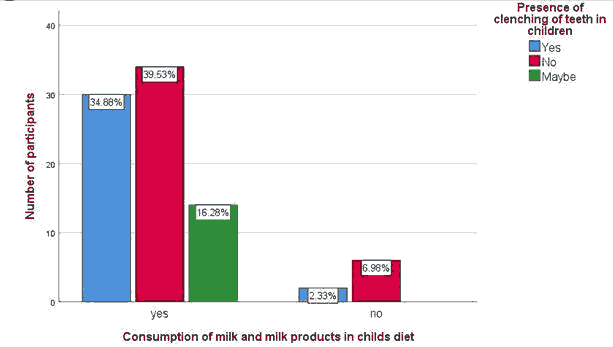
Figure 4: Bar graph showing response to the child consuming milk and milk products in their diet and its association to presence of clenching of his/her teeth at night (Blue graph depicts yes, red- no, green-maybe). X axis shows response to consumption of milk and milk products in diet and Y axis shows number of participants. 39.53% children consuming milk and milk products regularly do not have a habit of clenching teeth and 34.88% have a habit of clenching teeth. However this was statistically significant (Pearson’s chi square test; p value=0.00-significant).
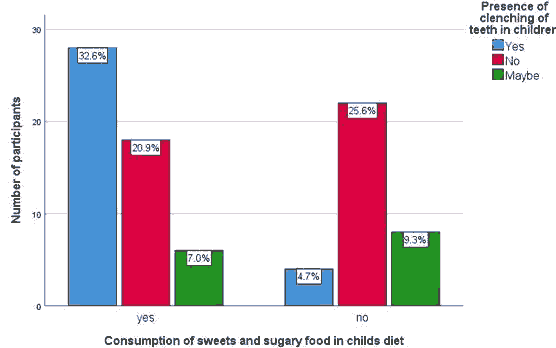
Figure 5: Bar graph showing response to the child consuming sweet and sugary in their diet and its association to presence of clenching of his/ her teeth at night (Blue graph depicts yes, red- no, green-maybe). X axis shows response to consumption of sweet and sugary food in diet and Y axis shows number of participants. 32.56% children consuming sweet and sugary food regularly have a habit of clenching teeth. However this was statistically significant (Pearson’s chi square test; p value=0.00-significant).
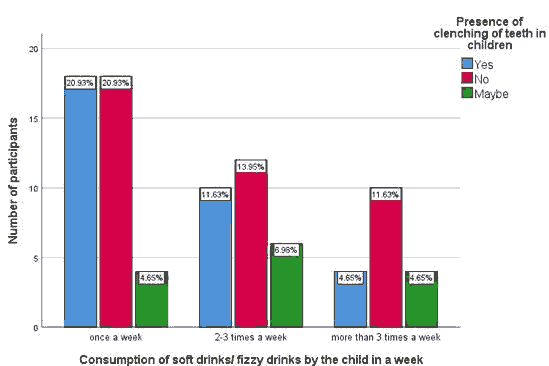
Figure 6: Bar graph showing response to the child having fizzy drinks in their diet and its association to presence of clenching of his/her teeth at night (Blue graph depicts yes, red- no, green- maybe). X axis shows response to consumption of fizzy drinks in diet once a week, 2-3 times a week, and more than 3 times a week and Y axis shows number of participants. 20.93% children having fizzy drinks once a week have a habit of clenching teeth. Only 4.65% of children having fizzy drinks more than 3 times a week show clenching of teeth. However this was statistically significant (Pearson’s chi square test; p value=0.00-significant).
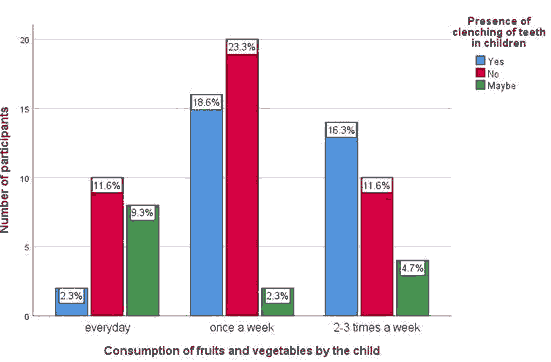
Figure 7: Bar graph showing response to the child having fruits and vegetables in their diet and its association to presence of clenching of his/ her teeth at night (Blue graph depicts yes, red-no, green-maybe). X axis shows response to consumption of fruits and vegetables in diet 2-3 times a week, every day and once a week and Y axis shows number of participants. 23.26% children having fruits and vegetables once a week do not have a habit of clenching teeth. Only 16.28% of children having fruits and vegetables 2-3 times a week show clenching of teeth. However this was statistically significant (Pearson’s chi square test; p value=0.00-significant).
Figure 8 depicts the response of parents regarding the presence of any abnormal oral habits in the children. It is seen that according to the parents, 48.84% of children have the presence of abnormal oral habits. Children have various adverse oral habits as they grow up. Figure 9 shows the distribution of various adverse oral habits in the children such as mouth breathing, thumb sucking, tongue thrusting and tooth grinding. It is seen that 27.9% of children have a habit of tooth grinding. Majority of children have mouth breathing habits more commonly (32.6%). Figure 10 shows response of parents regarding relation between sleep bruxism and dietary habits, 51.16% of parents believed that sleep bruxism may have a relation with the dietary habits of children. Parents are not well aware of the various treatment options for bruxism and almost 72.09% of parents were not aware of treatments done for children with sleep bruxism as shown in Figure 11.
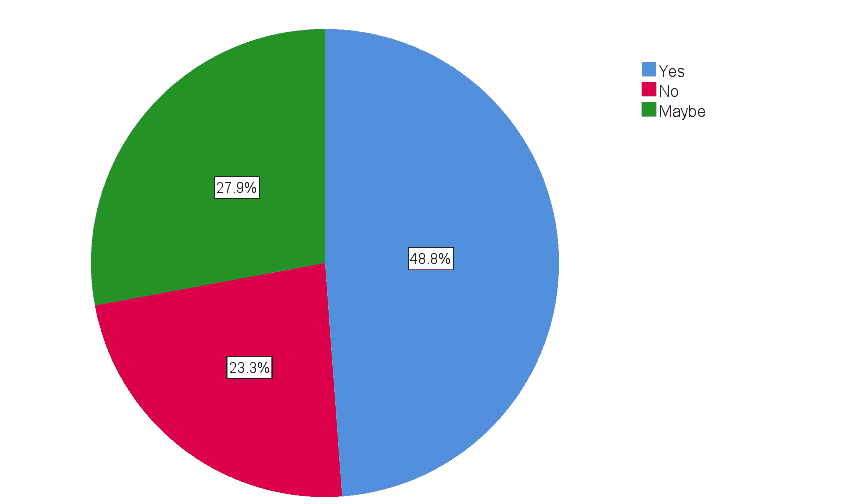
Figure 8: Pie chart showing response of parents regarding presence of any abnormal oral habits in the children (red represents no, green represents maybe, and blue represents yes). 48.84% of children have the presence of abnormal oral habits.
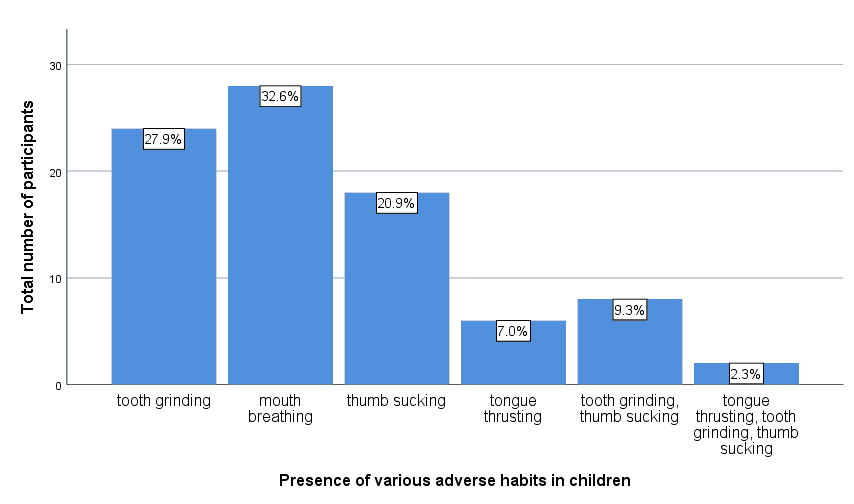
Figure 9: Bar graph showing presence of various adverse oral habits in the children such as mouth breathing, thumb sucking, and tongue thrusting and tooth grinding. X axis represents various adverse oral habits and Y axis represents total number of participants. 27.9% of children have a habit of tooth grinding.
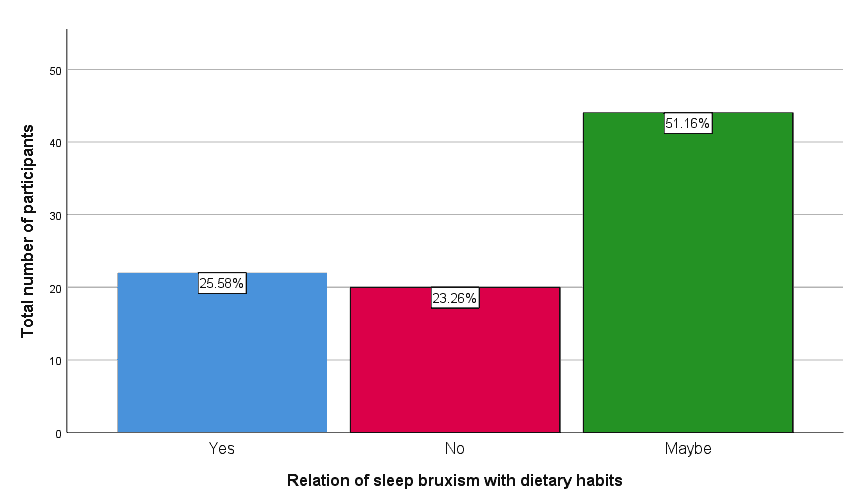
Figure 10: Bar graph showing response of parents regarding relation between sleep bruxism and dietary habits (red represents no, green represents maybe, and blue represents yes). X axis represents the response of parents regarding the relation between sleep bruxism and dietary habits and Y axis represents total number of participants. 51.16% of parents believe that sleep bruxism may have a relation with the dietary habits of children.
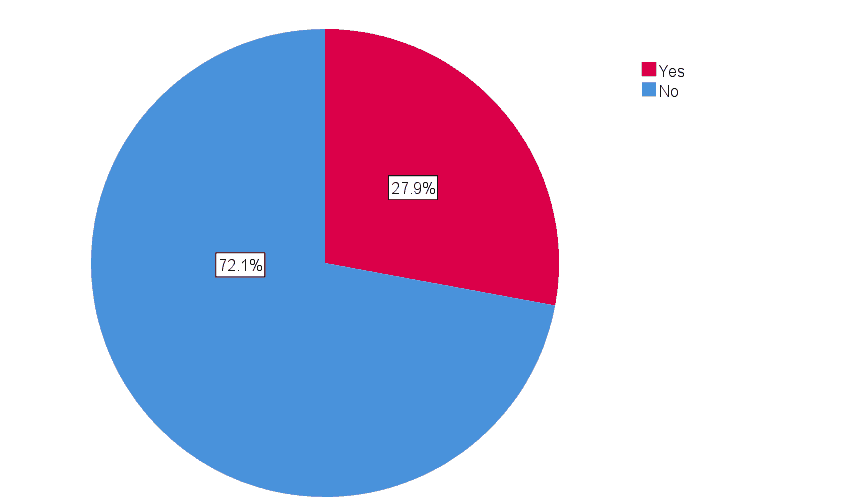
Figure 11: Pie chart showing response of parents regarding awareness of various treatments for sleep bruxism (red represents no, and blue represents yes). 72.09% of parents are not aware of treatments done for children with sleep bruxism.
Tooth wear can occur due to various potential factors, among which sleep tooth grinding and dietary habits is one of the factors. Unfortunately, there are limited reports on the effects of parental-report sleep tooth grinding and dietary habits, especially in children [11,32,33]. Overall, the findings show that Parental-report STG is not completely associated with tooth wear in the mixed dentition. The consumption of fruits and vegetables, sweets and chocolates, milk and milk products were found to be correlated with tooth wear patterns, but the correlation values are considered weak. Previous studies showed a positive association of parental-report STG and tooth wear in the mixed and permanent dentitions among children [11,32,33]. Regarding the dietary habits, previous investigations were done to assess the risk factors for tooth wear in the primary, mixed, and permanent dentitions and found a positive association with the consumption of soft drinks, nonnatural juices, citrus flavored sweets/gums, and citrus fruits [9,34]. It is seen that there is some amount of wear of permanent molars and deciduous canines in children with consumption of fruits and vegetables, sodas, and sweets and chocolates. According to the study by Restrepo et al. [35] increase in the consumption of fruits and vegetables has a clinical influence on the increasing severity of occlusal wear of teeth 16, 36 and 64, while sweets and chocolates have the same effect on the severity of wear of 16. Age has to be taken into account as an important cofactor when designing investigations on the etiology of tooth wear in the different dentitions and association with dietary habits [34].
One of the factors to be considered is the presence of mixed dentition, since the teeth eruption time is different among individuals and that plays a key role in such studies. This must be considered as a study limitation, since the time the teeth erupted and stood in the mouth cavity can show the variations in exposure to attrition, abrasion and erosion [35]. It is noted that sociodemographic factors and cultural practices influence dietary habits and their effects on tooth wear [36]. According to a study by Suwa et al. [37] eating a snack after dinner every day was found to be a significant risk factor for severe bruxism. This finding may indicate that sleep bruxism is independently associated with dietary factors. However additional research is needed to confirm any connection between dietary habits and bruxism.
Conclusion
Within the limits of the study it is conclusive that dietary habits can be related to parental reported sleep tooth grinding. In our study it is seen that children consuming bread and cereals, sweet and sugary food, soft/fizzy drinks have a higher incidence of sleep bruxism. However additional research is needed to confirm any connection between dietary habits and bruxism.
Acknowledgement
The study was supported by Saveetha Dental College & Hospitals, Saveetha Institute of Medical and Technical Sciences, Saveetha University, Chennai.
Conflict of Interest
There are no conflicts of interest as declared by the authors.
References
- Kreulen CM, Van’t Spijker A, Rodriguez JM, et al. Systematic review of the prevalence of tooth wear in children and adolescents. Caries Res 2010; 44:151-159.
- Al Halabi M, Al Kayoumi S, H Khamis A, et al. Prevalence of tooth wears in primary dentition in school children of Abu Dhabi, UAE. Applied Clin Res Clin Trials Regulatory Affairs 2016; 3:27-33.
- American Academy of Sleep Medicine. The international classification of sleep disorders: Diagnostic & coding manual. 2005.
- Ohayon MM, Li KK, Guilleminault C. Risk factors for sleep bruxism in the general population. Chest 2001; 119:53–61.
- Ahlberg J, Lobbezoo F, Ahlberg K, et al. Self-reported bruxism mirrors anxiety and stress in adults. Med Oral Patol oral Cirugia Bucal 2013; 18:e7.
- Manfredini D, Lobbezoo F. Role of psychosocial factors in the etiology of bruxism. J Orofac Pain 2009; 23:53– 166.
- Pizzol KE, Carvalho JC, Konishi F, et al. Bruxismo na infância: Fatores etiológicos e possíveis tratamentos. Revista Odontol 2013; 35:157-163.
- Kontaxopoulou I, Alam S. Risk assessment for tooth wear. Primary Dent J 2015; 4:25–29.
- Søvik JB, Skudutyte-Rysstad R, Tveit AB, et al. Sour sweets and acidic beverage consumption are risk indicators for dental erosion. Caries Res 2015; 49:243- 250.
- Murakami C, Oliveira LB, Sheiham A, et al. Risk indicators for erosive tooth wear in Brazilian preschool children. Caries Res 2011; 45:121-129.
- Restrepo C, Peláez A, Alvarez E, et al. Digital imaging of patterns of dental wear to diagnose bruxism in children. Int J Paediatr Dent 2006; 16:278-285.
- El Aidi H, Bronkhorst EM, Huysmans MC, et al. Multifactorial analysis of factors associated with the incidence and progression of erosive tooth wear. Caries Res 2011; 45:303-312.
- Govindaraju L, Jeevanandan G, Subramanian EMG. Comparison of quality of obturation and instrumentation time using hand files and two rotary file systems in primary molars: A single-blinded randomized controlled trial. Eur J Dent 2017; 11(3), pp. 376–379.
- Govindaraju L, Jeevanandan G, Subramanian EMG. Knowledge and practice of rotary instrumentation in primary teeth among Indian dentists: A questionnaire survey. J Int Oral Health 2017; 9:45.
- Panchal V, Gurunathan D, Shanmugaavel AK. Smartphone application as an aid in determination of caries risk and prevention: A pilot study. European J Dent 2017; 11:469–474.
- Ravikumar D, Jeevanandan G, Subramanian EMG. Evaluation of knowledge among general dentists in treatment of traumatic injuries in primary teeth: A cross-sectional questionnaire study. Eur J Dent 2017; 11(2), pp. 232–237.
- Jeevanandan G, Govindaraju L. Clinical comparison of Kedo-S paediatric rotary files vs manual instrumentation for root canal preparation in primary molars: A double blinded randomised clinical trial. Eur Archives Paediatr Dent 2018; 19:273–278.
- Nair M, Jeevanandan G, Vignesh R, et al. Comparative evaluation of post-operative pain after pulpectomy with k-files, kedo-s files and mtwo files in deciduous molars-a randomized clinical trial. Br Dent Sci 2018; 21:411-417.
- Ravikumar, D. et al. (2018) ‘DNA profiling of Streptococcus mutans in children with and without black tooth stains: A polymerase chain reaction analysis’, Dental research journal, 15(5), p. 334.
- Dhanalakshmi Ravikumar SN, Ramakrishna M, Sharna N, et al. Evaluation of McNamara’s analysis in South Indian (Tamil Nadu) children between 8–12 years of age using lateral cephalograms. J Oral Biol Craniofac Res 2019; 9:193.
- Ravindra V, Rekha V, Annamalai S, et al. A comparative evaluation between dermatoglyphic patterns and different terminal planes in primary dentition. J Clin Exp Dent 2018; 10:e1149.
- Ravindra V, Rekha CV, Annamalai S, et al. A comparative evaluation between cheiloscopic patterns and the permanent molar relationships to predict the future malocclusions. J Clin Exp Dent 2019; 11:e553.
- Subramanyam D, Gurunathan D, Gaayathri R, et al. Comparative evaluation of salivary malondialdehyde levels as a marker of lipid peroxidation in early childhood caries. Eur J Dent 2018; 12:67.
- Vishnu Prasad S, Kumar M, Ramakrishnan M, et al. Report on oral health status and treatment needs of 5–15 years old children with sensory deficits in Chennai, India. Special Care Dent 2018; 38:58-59.
- Jeevanandan G, Ganesh S, Arthilakshmi. Kedo file system for root canal preparation in primary teeth. Indian J Dent Res 2019; 30:622–624.
- Ramadurai N, Gurunathan D, Samuel AV, et al. Effectiveness of 2% Articaine as an anesthetic agent in children: Randomized controlled trial. Clin Oral Investigations 2019; 23:3543-3550.
- Ramakrishnan M, Dhanalakshmi R, Subramanian EMG. (2019) Survival rate of different fixed posterior space maintainers used in paediatric dentistry-A systematic review. Saudi Dent J 2019; 31:165–172.
- Panchal V, Jeevanandan G, Subramanian E. Comparison of instrumentation time and obturation quality between hand K-file, H-files, and rotary Kedo-S in root canal treatment of primary teeth: A randomized controlled trial. J Indian Society Pedodont Preventive Dent 2019; 37:75–79.
- Vignesh R, Ditto Sharmin C, Annamalai S, et al. Management of complicated crown-root fracture by extra-oral fragment reattachment and intentional reimplantation with 2 years review. Contemporary Clin Dent 2019; 10:397.
- Panchal V, Jeevanandan G, Subramanian EMG. Comparison of post-operative pain after root canal instrumentation with hand K-files, H-files and rotary Kedo-S files in primary teeth: A randomised clinical trial. Eur Archives Paediatr Dent 2019; 20:467–472.
- Samuel SR, Acharya S, Rao JC. School interventions- based prevention of early-childhood caries among 3-5-year-old children from very low socioeconomic status: Two-year randomized trial. J Public Health Dent 2020; 80:51–60.
- Lobbezoo F, Groenink WJ, Kranendonk AA, et al. A reliability study of clinical occlusal tooth wear measurements. J Oral Rehab 2002 ; 29:881-882.
- Fung A, Messer LB. Tooth wear and associated risk factors in a sample of Australian primary school children. Australian Dent J 2013; 58:235-245.
- Rios D, Magalhaes AC, Honorio HM, et al. The prevalence of deciduous tooth wear in six-year-old children and its relationship with potential explanatory factors. Oral Health Preventive Dent 2007; 5.
- Restrepo C, Manfredini D, Manrique R, et al. Association of dietary habits and parental-reported sleep tooth grinding with tooth wear in children with mixed dentition. BMC Oral Health 2017; 17:1-9.
- Mikkilä V, Vepsäläinen H, Saloheimo T, et al. An international comparison of dietary patterns in 9–11-year-old children. Int J Obesity Supplements 2015; 5:S17-21.
- Suwa S, Takahara M, Shirakawa S, et al. Sleep bruxism and its relationship to sleep habits and lifestyle of elementary school children in Japan. Sleep Biological Rhythms 2009; 7:93-102.
Author Info
Nashwah Hinaz1, Deepa Gurunathan1*, Nivedhitha MS2, Joyson Moses2 and Mahesh Ramakrishnan2
1Department of Pediatric and Preventive Dentistry, Saveetha Institution of Medical and Technical Sciences, India2Department of Conservative Dentistry and Endodontics, Saveetha Institution of Medical and Technical Sciences, India
3India
Citation: Nashwah Hinaz, Deepa Gurunathan, Nivedhitha MS, Joyson Moses, Mahesh Ramakrishnan, Association of Dietary Habits and Parental Reported Sleep Tooth Grinding Among Children in Chennai-A Questionnaire Study, J Res Med Dent Sci, 2021, 9 (S1): 36-42.
Received: 23-Feb-2021 Accepted: 10-Mar-2021 Published: 18-Mar-2021
Sources of funding : GB´s PhD-project on ethical challenges and decision-making in nursing homes has been financially supported by the Norwegian Extra Foundation for Health and Rehabilitation through EXTRA funds (grant no. 2008/2/0208).
